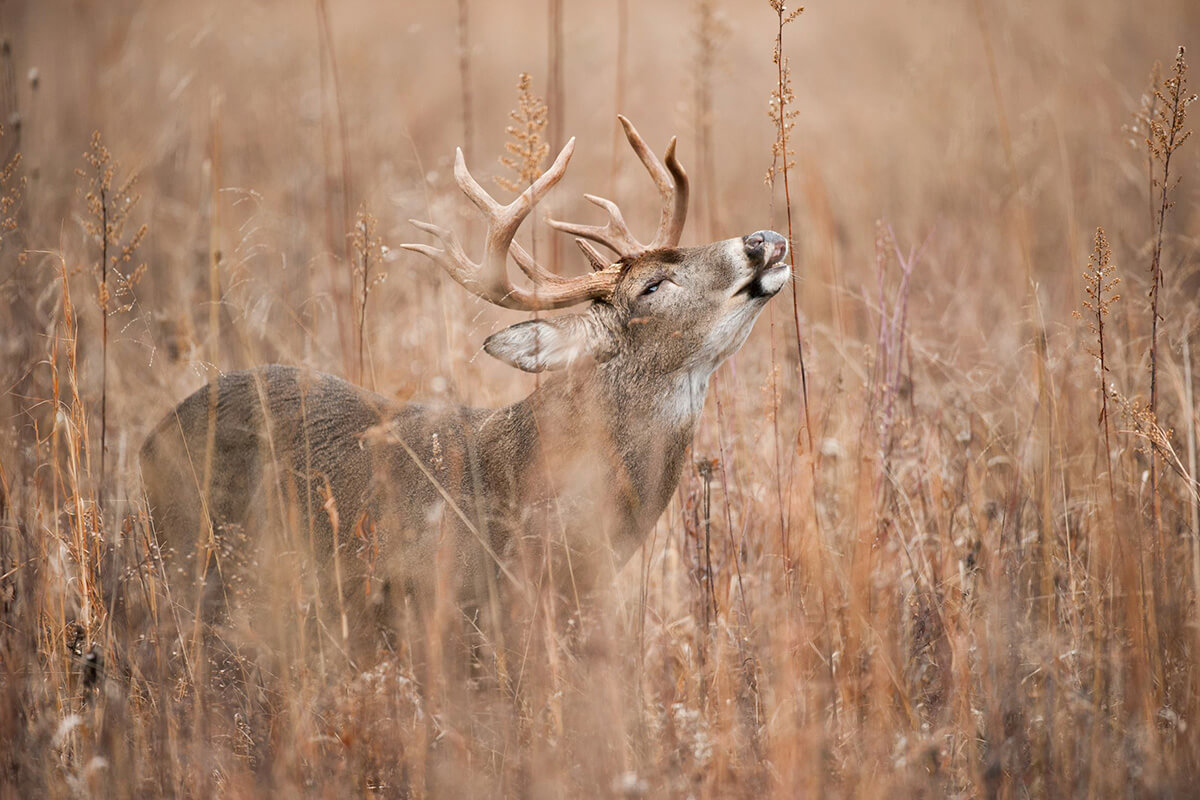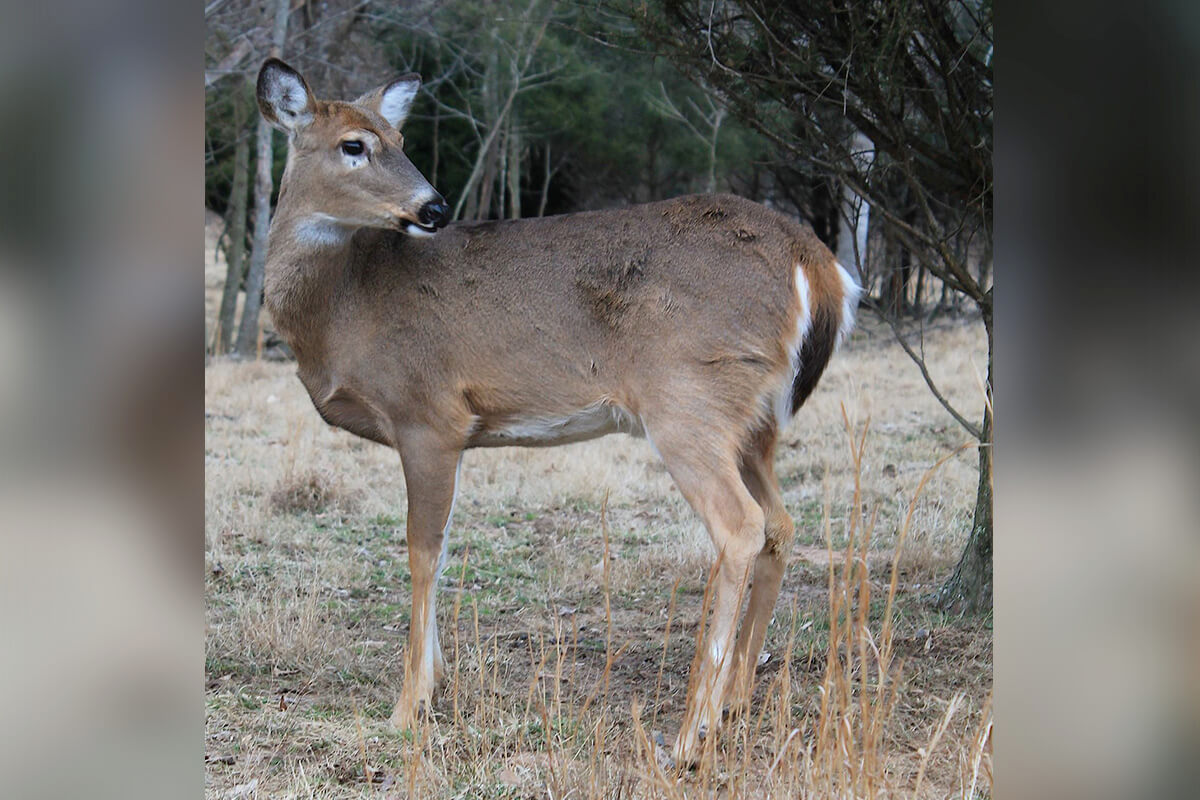
A mature whitetail buck does a flehmen, which is commonly called a lip curl. Bucks do this to stimulate their vomeronasal organ. (Photo by Matt Hansen)
A tip of the head here. A swish of the tail there. Hairs standing on end. Legs stiffening like a board. These things all mean something.
Whitetails are very communicative, even non-verbally. Having the knowledge to decipher exactly what deer are thinking as they use non-verbal cues is an advantage every hunter can have. These things help us know when to take shots, when to call and much more. Here’s what you need to know.
Basic Deer Behaviors
Just like a human’s attitude, you can identify a deer’s mood by studying his non-verbals. Let’s take a look at some deer “attitudes” (if you will) and how to identify them.
Relaxed is an easy mood to spot. This is common with bedded deer, and deer feeding in unpressured settings. These deer are loose in their movements, calm and might even act lazy. You might even see a tail swish.
Showing alertness is another common deer behavior. These deer are attentive, but they haven’t made any effort to make a move. Instead, their muscles are poised and partially flexed, ready for motion. The head is likely up, with the nose elevated and their eyes are usually locked on to the object in question; it might even do the head bob. An alert deer could even twist its ears, stress yawn or raise its tail.
Non-verbal cues can also show excitement in whitetails. These deer are hyped up about something, but they aren’t scared. Oftentimes, this involves interaction between multiple deer, or with other animals. Common bodily displays that show excitement include frolicking, jumping and head rolling.

Two deer behaviors that hunters often see are fear and uneasiness. Since deer are prey animals, they encounter danger on a regular basis, especially in areas with high predator populations and increased hunting pressure. Common displays that go with this grouping are an alert head, head bobbing, sniffing, stomping, a raised tail and raised hair.
For mature buck hunters, dominance is important to identify, too. Some deer are aggressive, and they show it. This is common when establishing the hierarchy and competing for food sources. Submissiveness, which is a response to dominance, is also visible. Submissive traits show other deer that they’re willing to subject to them.
Now, let’s look at specific areas on the body that help convey what a deer is thinking. This can be extremely important when making snap tactical decisions in the field, such as calling or taking a shot.
The Head
One of the most important areas for non-verbal communication is the head. It sends more messages than any other part of the whitetail’s body. You should certainly pay attention to it.
When a deer is alert, it typically holds its head up high. If it thinks it hasn’t been seen, it could be stationary, or might even look from multiple perspectives to see what caught their attention. The eyes and ears are usually forward.
As mentioned, the head bob (up and down or side to side) is another movement. While this technically isn’t a signal to other deer, other deer certainly understand that it sees something it doesn’t like. While the common belief is that deer are doing this to fake out their target, it’s more likely they are trying to see it from multiple angles to piece the image together; as deer see much differently than we do.
Another alert movement, but one that’s exhibited prior to detecting something, is ear turning. The ears will turn and swivel back and forth, acting similarly to a radar.

Throwing their nose up and sniffing the air is another action and signal. They’re trying to get the wind, and it tells nearby deer that they caught a slight whiff of something, or they are trying to smell something they saw or heard. Either way, it’s best to keep still and hold your breath.
The head roll, or better known as frolicking, is another form of body language. Oftentimes, this is done around other deer, and it comes across as playing. It’s more common with fawns, but adult deer can be seen doing this, too.
In contrast, head lowering is not a sign of playfulness. Rather, it shows aggression, especially if angled toward another deer. If done by bucks, this is paired with pinned ears and antler brandishing. If deer sense aggression from other animals, they will often stress yawn, which is also displayed in canines and other species. They’ll close their eyes, open their mouth and yawn.
An act that’s often misunderstood is flehmen, which is more commonly referred to as lip curling. Bucks do this when smelling a doe or urine. Some people claim this is the buck checking the estrus status of a doe, but that isn’t the case. Instead, the vomeronasal organ (which is located in the roof of the mouth and activated when lip curling) is used to elevate the buck to peak status. It is a built-in stimulant and performance enhancement, for lack of a better term.
The Legs
After the head, the next most important body parts to watch are the legs. The legs are crucial tools for whitetails, even when communicating with other deer. Look for the following things.
Stiff-legging and sidestepping is done by deer intending to send aggression toward other deer. Sometimes, this precedes a fight, but not always. Usually, it just lets the other deer know that the deer is aggressive. However, sometimes it leads to a charge, antler rush, buck rush or whatever you want to call it.
Hoof flailing and striking is another form of aggression with the legs. It’s more common among does and velvet bucks, but it is ultimately an antlerless attack form. All deer will do this at some point.
Bowing with the legs is a sign of submissiveness. This is when deer straighten and extend outward their front legs and lean downward. It’s a sign of accepting another whitetail’s dominance or status. It can also be a playful gesture.
Frolicking, which was previously mentioned, is mostly done with the legs. This playful nature requires the use of the deer’s head and legs. It’s very involving.
Stomping is another thing to watch for. When deer are alert, and see or suspect danger, they begin stomping the ground. The sounds and vibrations alert nearby deer. Stomping also leaves behind scent, which falls from the interdigital gland located on the hoof.
Another form of stomping is done by mature bucks. When a doe is in or near estrus, but is unwilling to cooperate, bucks oftentimes stomp in frustration; talk about throwing a temper tantrum!
The Tail
Likely the most iconic body part for deer — and the one the species is named after — the tail is very important. The tail has been key for whitetail survival since its creation, and knowing why that is and what it means to a deer is very useful.
Deer sticking their tail straight out can indicate different things. You’ll often see deer do this while walking with their head down. It’s an even-toned message. But more often, does that are in estrus will do this.
A tail that is tucked translates to a deer that is either hurt badly, feels submissive or doesn’t want to draw attention. For example, it’s common for wounded deer to run with their tail down. Also, mature bucks that get spooked sometimes run off without flagging, so they can remain unseen.
Similarly, tail flickering is best seen as a tail that’s in a low position and is slightly twitching back and forth. Generally, this is done after a deer is shot. Tail swishing is similar to flickering, but it is done in larger movements. The tail is usually higher, and it goes further left and right. Deer do this for two reasons. First, it signals all clear after previously being on alert. Secondly, they’ll do this to keep bugs off of them.
In contrast, a deer that raises its tail while standing or walking and doesn’t wave it, is telling other deer to “watch out.” While danger might not be detected or understood just yet, they’re telling the rest of the herd that something might be amiss; and it also helps keep the group together. Likewise, flagging is when deer wave their tail back and forth with it raised up. It’s usually exhibited as the deer runs off. This is telling all deer nearby that it’s time to go, danger is present.
The Hair
Finally, even a whitetail’s hair can send messages. Understanding hair signals is a way to take your whitetail body language knowledge to the next level. For example, raised head, neck, back and possibly side hair is usually done by deer that are posturing toward other animals. Sometimes, this is done out of aggression. Other times, it’s merely a defense mechanism to appear larger than they actually are.
Raised rump and tail hair is typically done by deer that are alert and afraid; it’s usually expressed just before flight. It’s common to see this when coyotes and other predators appear on the scene. All hair raising can indicate both instances, too.
In closing, deer hunters spend time perfecting their craft in many ways, but oftentimes fail to learn the game they’re pursuing. Take the initiative to become fluent in the non-verbal communication of your quarry: learn whitetail sign language.













